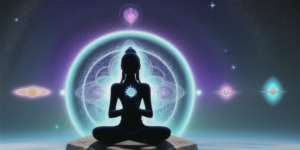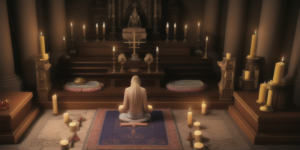It is essential to understand that life is a dance of contrasts. Light has meaning because of darkness, and joy has depth because of the pain. Our lives are replete with alternating moments of suffering and ecstasy. Each period of suffering creates the possibility for a subsequent period of bliss, like waves following troughs in the ocean.
Suffering and ecstasy are two sides of the same coin. Where there is pain, there is the potential for joy, much like the calm after a storm. This isn’t a call to glorify suffering but to acknowledge that our most challenging moments can cultivate the fertile ground from which happiness can bloom. When the clouds of anguish start to part, there is a certain clarity and freshness that can only be appreciated in contrast to what has been endured.
Society often conditions us to avoid pain at all costs. However, the initial phase of pain, be it depression, loss, or anxiety, is a natural part of life. Embracing suffering involves acknowledging its existence without resistance. It is about being present with the pain and not letting it define one’s identity. By embracing the pain, one allows it to serve its purpose and pave the way for the ecstasy that is to follow.
One of the crucial aspects of transforming suffering into an opportunity for growth is being present. Often, the weight of past experiences and the anxiety of future prospects cloud our ability to stay present. Engulfed in the memory of pain, we might miss the knock of happiness on our doors. By staying alert and open to the present moment, we create the space necessary for joy to enter our lives.
Being present is an art form in itself. It requires a gentle balance of acknowledging what we’re going through without clinging to it. In the face of depression or any form of suffering, we must learn to simply be – to exist within the ebb and flow without trying to paddle against the current. The idea is not to suppress the pain or to fight it but to allow it to naturally run its course.
When you find yourself immersed in the depths of depression. Instead of engaging in a battle with your emotions, allow them to flow through you like a river. Diverting your attention or burying your feelings is akin to building a dam; it only amplifies the pressure. Rather, become an observer, and delicately acknowledge the emotions and thoughts as they come.
Depression, in its raw form, is a tapestry of thoughts woven by your mind – thoughts that you have come to believe define you. However, these are often conditioned beliefs, not the essence of who you are. By recognizing this distinction, you start to see the fluid nature of your mental state.
It is crucial to understand that depression can be a catalyst for profound personal growth and self-discovery. It is, in fact, beautiful. It is through this contrast, this yin and yang, that the true understanding of joy emerges. For light is most appreciated in darkness, and satiation most cherished in hunger.
Depression, in this context, is not an enemy, but a guide. It takes you on a journey through the valleys, so you can appreciate the peaks. It teaches you about your inner strength, resilience, and the boundless joy that resides within you.
However, it’s important not to become entangled or identify with the depression. Feeding it with worry or desperately trying to suppress it acts like fuel to the fire. Instead, let the feelings of depression be a whisper, not a storm. Respond with gentle acceptance and mindful observation, knowing that this, too, shall pass. Nothing stays forever, not even your depression.
In essence, depression can be seen as an invitation – a call to delve deeper into oneself and to emerge with a newfound appreciation for joy and life. When we understand that sadness and joy are not adversaries but two sides of the same coin, we begin to comprehend the holistic nature of human experience.
Therefore, let the dualistic mind reveal its play, and in doing so, allow yourself to be a spectator, a witness on this journey. With an open heart and a gentle spirit, let depression be the canvas on which true joy paints its most beautiful artwork. Through this realization, we embrace an eternal truth – that in embracing our shadows, we find our light.
By embracing this state of being, we open ourselves up to the spontaneous moments of ecstasy that can follow. Like the morning sun that emerges from the night, these moments, however fleeting, have the power to invigorate and heal.
The Danger of Secondary Pain:
While primary pain is a natural part of life, secondary pain is the pain we inflict upon ourselves through our reactions to primary pain. For example, if one is depressed, acknowledging and allowing that depression to exist is dealing with primary pain. However, getting depressed about being depressed, and fighting it, constitutes secondary pain. Secondary pain is often more harmful as it is self-inflicted and keeps us entangled in mental loops.
Dwelling on suffering can be likened to wearing blinders that obscure the potential ecstasy waiting just around the corner. By obsessing over our pain, we become prisoners of our past experiences. This not only taints our present moments but robs us of the ability to recognize and embrace the joy that follows. The key here is to acknowledge the pain without allowing it to consume our identity.
Imagine you are caught in a sudden rainstorm while walking outside. The rain soaking your clothes and the discomfort of being wet is like the primary pain – it’s a direct result of the circumstances and something natural that you can’t immediately change.
Now, envision that instead of seeking shelter or putting on a raincoat, you start to panic. You become furious at the sky, resent the rain for ruining your day, and worry incessantly about catching a cold or how others might perceive your drenched appearance. This mental and emotional turmoil you create in response to the rain is akin to secondary pain.
In this analogy, being caught in the rain represents the natural occurrence of depression or emotional pain in life. The act of seeking shelter or adapting to the situation is like acknowledging the pain and allowing it to be, without trying to fight it.
Conversely, the panic, anger, and worry represent the secondary pain. This is the emotional struggle and mental distress we inflict upon ourselves in reaction to the initial pain. Like how panicking in the rain only makes the experience more unpleasant without changing the weather, getting tangled in negative reactions to emotional pain only exacerbates the suffering without resolving the underlying issue.
By understanding that sometimes it rains, and that’s a part of life, and by adapting accordingly without additional anguish, we can address the primary pain effectively and avoid unnecessary secondary pain.
Life as a River:
Picture life as a river. It flows naturally; sometimes it is calm, while other times it is turbulent. When we try to control or change the course of this river forcefully, we struggle. On the other hand, when we let it flow naturally, accepting its twists and turns, we flow with it. This acceptance is not a passive resignation but an active engagement with life as it unfolds.
Religiousness in Trust:
This approach does not call for belief in a deity or God but rather, cultivating a trust that everything in life serves a purpose. This kind of trust is a form of religiousness. It’s about having faith that even the storms are for the sake of the calm that follows. When one embodies this trust, suffering loses its grip. The pain becomes a stepping stone, an opportunity to delve deeper into the ecstasy of existence.





